Brand Content (GOLD)
Client Credits: HP Canada
Country Marketing Manager: Esteban Davila
Country Marketing Lead, Commercial & Consumer Personal Systems: Jeanette Kennedy
Agency Credits: Edelman
Chief Creative Officer: Andrew Simon
Managing Director, Specialties: Tristan Roy
VP, Paid Media: Chris O’Hara
VP, Digital: Neil Mohan
VP, Digital: Melissa Turlej
VP, Technology: Michael Thomson
Senior Account Director: Nick Turney
Senior Account Manager: Mitch Bell
Senior Account Manager: Alexandra Krivov
Senior Account Manager: Jordan Blagdon
Art Director: Hira Gomes
Account Manager: Rebecca Myers
Senior Account Executive: Amber Mulder
Director: Hubert Davis
Editor: Dave De Carlo
Executive Director: Tom Evelyn
Producer: Tom Wilson
Untitled Films
Rooster
Section I — CASE PARAMETERS
| Business Results Period (Consecutive Months): | December 2016 – July 2017 |
| Start of Advertising/Communication Effort: | December 2016 |
| Base Period as a Benchmark: | January 2016 – December 2016 |
| Geographic Area: | Canada (including Quebec) |
| Budget for this effort: | $500,000 – $1 million |
Section IA — CASE OVERVIEW
Why should this case win in the category (ies) you have entered?
The ‘Inside the Head of a Hacker’ case demonstrates how Edelman Canada, working in partnership with HP Canada, created a Canadian-born B2B campaign that transformed a much-ignored product and service offering in a major sales success.
As the Canadian division of the global HP brand, HP Canada has traditionally relied on localized global content to support brand level marketing efforts. But fueled by research and a strong insight and idea, we launched our own homegrown effort to promote HP’s Printer Security solution to Canadian IT decision makers. Not that it didn’t come with its fair share of challenges. For instance, we had to convince the world’s largest information technology company to hire Canada’s most notorious hacker.
In the end, we delivered a hyper-local, 360-degree campaign that drove a 174% increase in HP’s sales pipeline, valued in the millions. And the campaign’s success grew well beyond Canada with our infamous hacker, Michael ‘MafiaBoy’ Calce, being signed on as an international spokesperson for HP.
Section II — THE CLIENT’s BUSINESS ISSUES/OPPORTUNITIES
a) Describe the Client’s business, competition and relevant history:
HP is predominantly known as a consumer technology brand, with a long-standing history as a key player in the PC/laptop market and to a lesser extent, consumer print market. However, following a well-documented split into two separate companies, the PC/print-focused entity (HP Inc.) has made significant investments within the printer category both in terms of R&D and by acquiring Samsung’s print business in September 2016. Although HP held a 58% of the commercial print market share (as of May 2016) in Canada, * the print security market was basically nonexistent. HP needed a marketing campaign that positioned it as an industry leader in cybersecurity – a highly competitive space HP was not well known within.
*(IDC – Multi-country Market Share Report 2016)
HP is predominantly known as a consumer technology brand, with a long-standing history as a key player in the PC/laptop market and to a lesser extent, consumer print market. However, following a well-documented split into two separate companies, the PC/print-focused entity (HP Inc.) has made significant investments within the printer category both in terms of R&D and by acquiring Samsung’s print business in September 2016. Although HP held a 58% of the commercial print market share (as of May 2016) in Canada, * the print security market was basically nonexistent. HP needed a marketing campaign that positioned it as an industry leader in cybersecurity – a highly competitive space HP was not well known within.
*(IDC – Multi-country Market Share Report 2016)
b) Describe the Client’s Business Issues/Opportunities to be addressed by the campaign:
As dominant as HP was from a printer manufacturer standpoint, selling businesses on security services was another matter altogether. IT decision-makers had historically allocated their security spend towards more inherently mobile devices such as smartphones, tablets, and laptops. In fact, research showed that only 38% of IT decision-makers perceived printers to be risky devices in terms of security breaches, compared to 50+% for other devices. ** Furthermore, while printers are among the top five devices most commonly connected to a network, they have the lowest rate of security practices (47% vs. 58-76%.) **
HP was far from the leader in security. IT decision-makers perceived Cisco to be the most credible vendor for IT security expertise (63%), followed by Microsoft (56%), with less than 50% saying HP was a credible security expert. **
**(Spiceworks – Canadian Survey December 2015)
c) Resulting Business Objectives: Include how these will be measured:
1. Increase HP’s sales pipeline for its print security products and services.
2. Drive 20,000 clicks to the campaign landing page in order to further educate our target audience about the business value of print security and HP’s product/service solutions.
3. Raise awareness of Print Security as a category while elevating HP as an industry thought leader.
Section III — YOUR STRATEGIC THINKING
a) What new learnings/insights did you uncover?
Through interviews with the HP sales team, ITDMs, and third-party industry consultants, we confirmed that although security was a top priority for IT departments, printers were not included within the primary consideration set.
Before we could get our target to consider HP printer security as a solution, we had to get them to better understand the potential threat to their business. Given technology decision makers were well-versed in the general topic area, we knew generic scare tactics wouldn’t resonate. We needed to go deeper.
The thing about hacking is that it’s a faceless crime. When you can’t picture an enemy, the threat doesn’t seem real. In other words, if you don’t truly appreciate the risk, you don’t understand why you need HP’s solution.
b) What was your Big Idea?
To help IT decision-makers and Chief Information Security Officers internalize the looming danger, we needed to give them intimate knowledge of the kind of person who was trying to infiltrate their business.
c) How did your Communication strategy evolve?
After an exhaustive search for our hacker which included rigorous vetting by HP’s global Print Security team, we secured the biggest Canadian hacker of them, a man who Listverse named as one of the world’s top 10 black hat hackers of all time. Michael ‘MafiaBoy’ Calce was 15 years old when he infamously hacked many of the world’s largest online businesses including Amazon, CNN, Yahoo (then the world’s largest search engine), eBay, and Dell, causing an estimated $1.7 billion in loss. Given Michael’s incredible history, we made him the centerpiece of our campaign.
While HP had planned to have a booth at key IT security conferences in Toronto and Montreal where our target would sure to be in attendance, we saw a way to increase the brand’s impact with MafiaBoy. To that end, we pitched the organizers of each conference on allowing a keynote presentation by Canada’s most infamous hacker (without any additional investment by HP.) We were successful in both cases, turning what would have been a minimal presence into a headlining status and lead generation opportunity.
Because we saw the value for our target audience in hearing from MafiaBoy himself, we decided to take his story to the biggest screen of all in the form of a 20-Minute Short Documentary called ‘Rivolta’ (the code name he gave his first cyberattack.) Working with Academy Award nominated director Hubert Davis, we created a unique, first-person account of MafiaBoy’s story, in the process revealing a hacker’s motivations, tricks of the trade, and why today, there’s no such thing as being too safe.
Once the film was complete, we began our distribution strategy. To create buzz for the film, we decided to target North America’s most prestigious documentary film festival, Hot Docs. We submitted our film to Hot Docs and were honoured to become the first brand-associated film in the festival’s history.
Once accepted, we adjusted our communications strategy to mimic a true film promotion. This became our integrated marketing campaign, consisting of a movie trailer, microsite, OOH, movie poster and ad, press junket, and experiential stunt.
d) How did you anticipate the communication would achieve the Business Objectives?
In a marketing space dominated by whitepapers and webinars, we did something truly unique and distinct to cut through the noise.
While the majority of B2B campaigns were conservative in nature, we knew that given the subject matter our target would appreciate something different. By surrounding our target audience with rich content in contextually relevant moments, we were confident that we could drive engagement and most importantly qualified leads to the HP sales team.
Section IV — THE WORK
a) How, where and when did you execute it?
The campaign launched on March 1, the first day of Fraud Prevention Month with a multiple-page article in the National Post detailing MafiaBoy’s partnership with HP, the vulnerabilities of unsecure printers and the upcoming Documentary film ‘Rivolta’. Alongside the National Post article, we launched teaser content driving to our theatrical trailer on YouTube and Facebook as well as technology/business hubs: LinkedIn, Spiceworks & IT World Canada (where ITDMs congregated for industry news/content.) The teaser and theatrical content introduced MafiaBoy’s story and closed with the cryptic message that ‘Rivolta’ was coming soon.
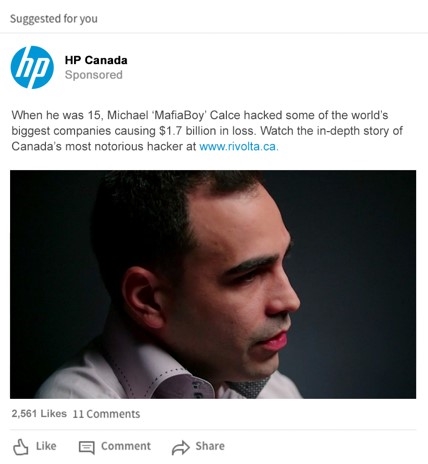
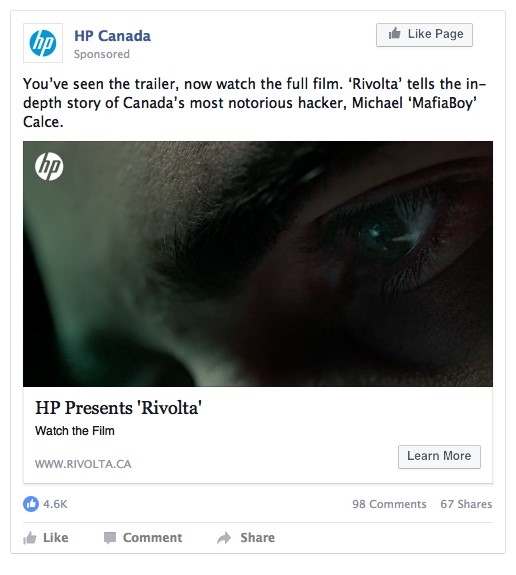
Our campaign landing page (rivolta.ca) was a one-stop-shop for IDTMs to watch the trailer, learn more about HP’s print security offering, download a whitepaper and take a print risk assessment quiz. Once released, the full film was also available on the landing page.
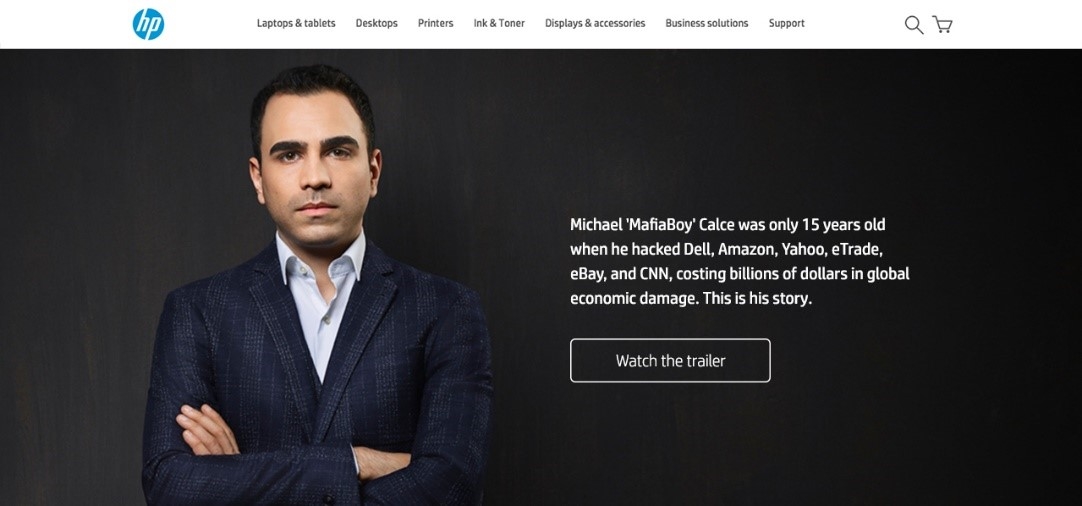
To maintain momentum leading up to the release of the full film, we placed a full-page movie poster ad in the Globe and Mail’s Fraud Prevention Month Insert.
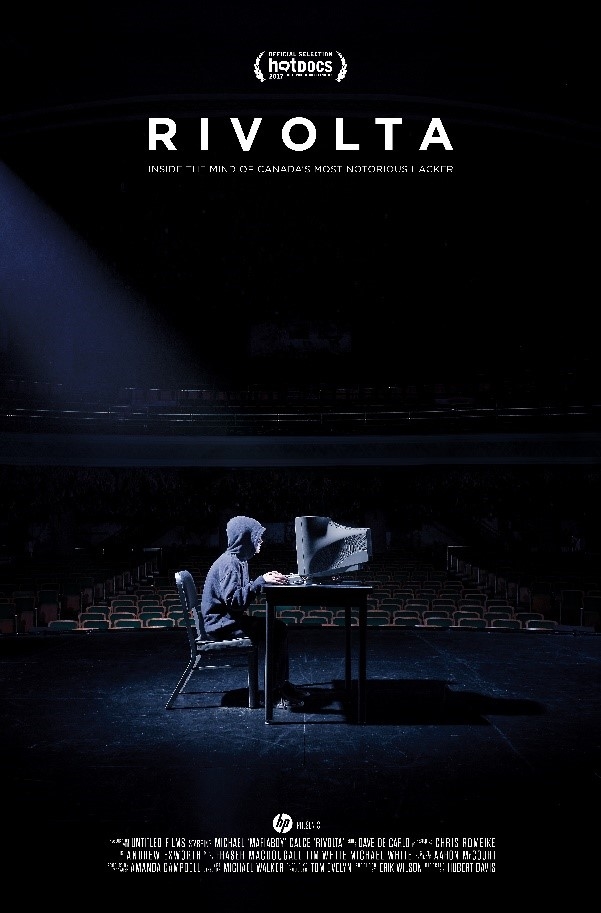
‘Rivolta’ premiered at Hot Docs International Documentary Film Festival in late April after becoming the first piece of branded content to be selected. Leading up to the premiere, movie posters blanketed King Street West alongside the TIFF Bell Lightbox where the world premiere was held. To ensure that the premiere screen audience left knowing the seriousness of cybercrime, the premiere itself was hacked. We obtained basic information from theatregoers on their way into the film and then surprised them with highly personalized digital outdoor messages after the screening.
After three sold out screenings at Hot Docs, we launched the film online across YouTube, Facebook and our campaign landing page, supported by an additional movie poster placement in the Financial Post. Online, we leveraged retargeting to deliver it directly to users who had already engaged with our theatrical trailer during phase 1 of the campaign.
Alongside the film promotion and media tour, MafiaBoy also delivered 10 keynote presentations at security conferences across North America and the UK, delivering his story and HP’s print security message directly to ITDMs and CISOs as well as media.
c) Media Plan Summary
Our Media strategy was to combine traditional film promotion tactics, contextualized for a business audience.
Promoting a 20-minute video presented the challenge of keeping an audience with a short attention span engaged but also an opportunity to get creative – our focus was serving the right content, at the right time to the right device.
- Leveraging short form video: We launched the campaign with 15s teaser content and theatrical trailer across social/digital channels to introduce our audience to the campaign with easily digestible content and create a cookie pool, which allowed us to serve the full-length documentary directly to users who had already engaged with teaser/trailer content.
- Dayparting: Given that we targeted a business audience, we knew that expecting them to consume long form video during the work day would be difficult, so we deliberately delivered the majority of impressions via short form teaser content and allocated spend towards the full-length documentary during the evening and weekends.
- Device Optimization: To ensure the best user experience, we optimized the spend of the full-length documentary to desktop/laptop devices and optimized our trailer and teaser content to mobile devices.
- Two-Pronged Earned Media Campaign: During the initial launch of the campaign, we drove earned media coverage in tier 1 and trade publications with stories focused on print security and MafiaBoy’s new partnership with HP. During our second phase of earned media outreach, we focused on ‘Rivolta’s” world premiere at Hot Docs and generated coverage across entertainment and broadcast media, with MafiaBoy serving again as our spokesperson.
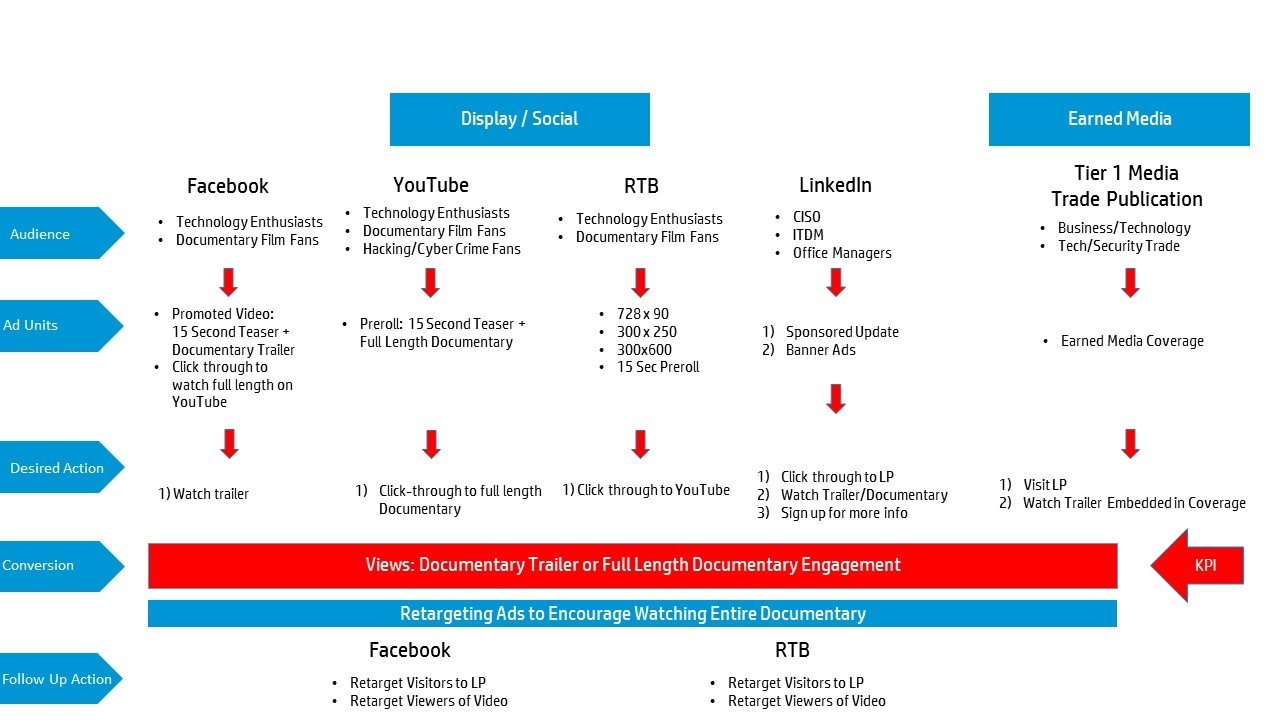
Section V — THE RESULTS
a) How did the work impact attitudes and behaviour?
The impact of the campaign among our target audience of ITDMs and CISOs was evidenced by the direct feedback on Michael’s presentation gathered at various security conferences during his speaker tour.
“Excellent presentation, nice to know how a hacker thinks.” – Mukta Soni, Sr. Compliance Manager, Just Energy Group Inc.
“Fantastic. I am fully aware of this content but it was exceptional to hear it from a hacker perspective.” – David Hitchcock, Information Security SME / Architect
“You have to think like the bad guy to stop the bad guy… absolutely” – Richard Godsmack, CISO, McMaster University
An important offshoot of our campaign was the manner in which it energized the HP sales team. Frankly, they weren’t used to this kind of all-encompassing effort and by applying so much focus to a much-ignored product/service offering gave them confidence that the company was committed to this segment of the business.
b) What Business Results did the work achieve for the client?
The campaign resulted in a 174% increase in HP’s enterprise print sales pipeline.
c) Other Pertinent Results
‘In the Head of a Hacker’ eclipsed all campaign benchmarks, resulting in 10M earned impressions (projection: 6M), 1.7M video views (projection: 1M), and 35K clicks to the microsite (projection: 20K). The fact that it premiered at the Hot Docs Festival created an opportunity to entertain key customers and partners. The Documentary itself was recognized with a Bronze Lion at the Cannes Festival of Creativity and has just recently been shortlisted at the Clios (winners announced late September in New York.)
d) What was the campaign’s Return on Investment?
Due to HP’s policy on proprietary sales pipeline figures, we are unable to share these figures. But given the success of ‘In the Head of a Hacker,’ we are currently in planning for a campaign extension. Also of note, the US has embraced our original work and deployed MafiaBoy as an international speaker with the support of the Documentary Trailer. In other words, our Canadian work is paying dividends on both sides of the border.
Section VI — Proof of Campaign Effectiveness
a) Illustrate the direct cause and effect between the campaign and the results
This was HP’s first marketing campaign in support of their Print Security product and service offering and resulted in a significant increase in sales pipeline. The US recognized Michael’s value and signed him as a global spokesperson for Print Security – delivering over 25 keynote speeches across the globe.
b) Prove the results were not driven by other factors
Campaign spend vs. history and competition:
The ‘In the Head of a Hacker’ campaign was the only Print Security focused marketing effort in market within Canada during the time of the campaign. There were no pricing incentives or unusual sales promotion activity in the period.
Pre-existing Brand momentum:
This was the first campaign for Print Security, there was no pre-existing brand momentum.
Pricing:
Pricing is proprietary information and can’t be shared.
Changes in Distribution/Availability:
There were no distribution changes.
Unusual Promotional Activity:
There was no unusual promotional activity.
Any other factors:
N/A